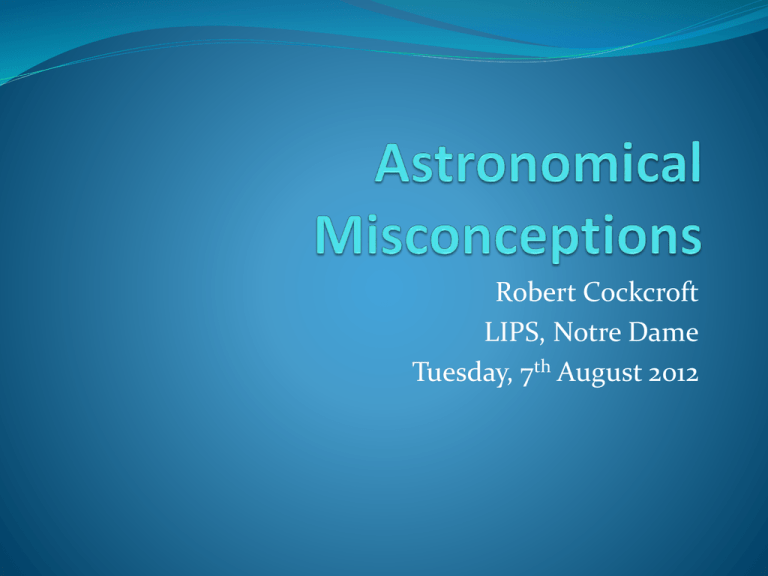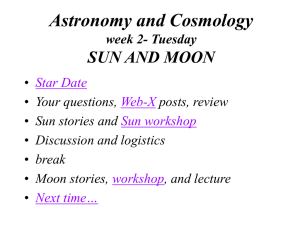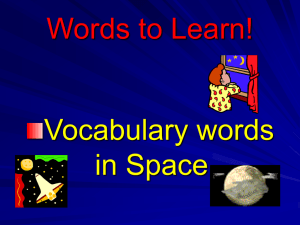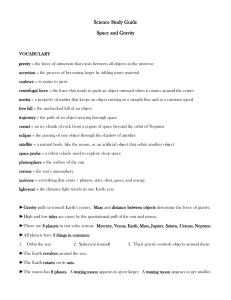Astronomical Misconceptions
advertisement

Robert Cockcroft LIPS, Notre Dame Tuesday, 7th August 2012 Outline “Our brains help us to survive, not to comprehend the cosmos.” – N. Comins, Heavenly Errors (2001) Origins Why we develop them How to avoid in the future How to get rid of old ones (the hard part) Interactivities: What is a misconception? Common misconceptions How to avoid them in the future What is a misconception? Definition: Broader misunderstanding Might not know that you’re wrong Cognitive error Not understanding a concept or structure There is a correct conception – you haven’t got it Could be a logical conclusion, but based on bad facts Not understanding what you’re seeing Incorrect mental map so can’t properly interpret Applying cause and effect to something that you can’t Might not be based on factual error – just conceptual Misconceptions might change over time Mistaken model – something you have no experience with Knowledge is quite relative What is a misconception? The difference between scientific reality and perception (AND/OR BELIEF) They can scale from incorrect fact to deep-seated, long-held framework E.g., “prior beliefs” have less negative connotations and are less likely to make people defensive Origins (1 of 2) Taught/Learned/Memorized incorrectly Misinterpreted, reasoning is faulty Sci-fi misrepresentations Cartoons Pop culture Transferring everyday occurrences to the cosmos Missing information Inaccurate/incorrect observations Origins (2 of 2) Words themselves Poor memory Common sense Media AND SOCIAL MEDIA Overgeneralizations Permanence Emotional ties to beliefs Some math may be required DISCRETE DISTINCTIONS IN TEACHING CAN EXASCERBATE MISCONCEPTIONS SIMPLIFICATIONS OF INITIAL TEACHING CAN CAUSE PROBLEMS LATER ON DYNAMIC NATURE OF SCIENCE – OUR KNOWLEDGE IS EVOLVING SUSPICIOUS OF SCIENCE, STUBBORNLY HOLD TO BELIEFS INABILITY TO UNDERSTAND MICRO/MACRO SCALES – WE THINK EVERYTHING IS HUMAN-ORIENTED Misconceptions can propagate Common Misconceptions from McCallion Planetarium Audiences Seasons (due to axial tilt not closeness to the Sun) The planetarium is not an observatory (the dome will not open) The planetarium is not a live feed, but rather a computer simulation We project on a 2D surface, but the objects have distances (i.e., it's all 3D) Eclipses - the difference between solar and lunar BHs don't “suck” We can't see the Moon during the day Why is the sky blue? Not because of water reflection Astrology (and horoscopes/zodiac signs) vs. astronomy Conspiracy theories (Moon landing, aliens) How to engage Christian groups (e.g., requests not to mention evolution or the age of the Universe, "only Jesus can escape from BHs") Common Misconceptions In your experience: Astronauts on Mars Earth is the only place with gravity – there is no gravity in space Space is empty Scale of the Universe Moon phases Everything has an atmosphere Planet X – so many potentials Doomsday Magnetic fields flip Floating in space BHs as a passage to another place Maximum distance of manned flight Planets shine by their own light (JAAP: big problem in the Netherlands’ exam writers) Planets are bigger than stars Polaris is the brightest star Moon phases caused by Earth’s shadow Sky turns exactly once We just take space shuttle to the Moon People are on ALL spacecraft Space is far away Daily vs. weekly/monthly/annual motion Show me the Star of Bethlehem Sun causing global warming Buying/naming stars We have two Suns (the other one is Nemesis) Mars is as big as the full Moon Magical planetary alignments Planetary alignments are common 50 Most Common Misconceptions According to N. Comins: 1. Pluto is always the farthest planet from the Sun. 2. Stars really twinkle. 3. The Sun primarily emits yellow light. 4. There are twelve zodiac constellations. 5. The constellations are only the stars making the patterns. 6. Saturn is the only planet with rings. 7. Seasons depend on the distance between the Earth and the Sun. 8. Polaris, the North Star, is the brightest star in the night sky. 9. The asteroid belt is densely packed, as in Star Wars. 10. Giant planets (Jupiter, Saturn, Uranus, and Neptune) have solid surfaces. 11. We see all sides of the Moon from the Earth. 12. Black holes are huge vacuum cleaners in space, sucking everything in. 13. All planets have prograde rotation (they spin in the same direction as they orbit the Sun). 14. The only function of a telescope is to magnify. 15. A shooting star is actually a star falling through the sky. 16. Comet tails are always behind the comet. 17. Black holes last forever. 50 Most Common Misconceptions 18. 19. 20. 21. 22. 23. 24. 25. 26. 27. 28. 29. 30. 31. 32. 33. 34. All moons are spherical. Only the Moon causes tides. Ours is the only moon. The Sun is a unique object, not a star. Pulsars are pulsating stars. Spring tide only occurs in the spring. Saturn's rings are solid. The Sun will last forever. The Sun shines by burning gas or from molten lava. There is a permanently dark side of the Moon. Black holes are empty space or holes in space. The Sun doesn't rotate. The Sun is solid. All stars are yellow. The Moon is not changing distance from the Earth. Stars last forever. There are many stars in the Solar System. 50 Most Common Misconceptions 35. 36. 37. 38. 39. 40. 41. 42. 43. 44. 45. 46. 47. 48. 49. 50. The Sun always rises directly in the east. Meteors, meteorites, meteoroids, asteroids, and comets are all the same things. The Galaxy, the Solar System, and the Universe are all the same thing. The Big Dipper is a constellation. Mercury is hot everywhere on its surface. Gravity is the strongest force in the universe. Once the ozone is gone, it's gone forever. There are only a few galaxies in the universe. The universe is static or unchanging. The center of the Moon's core is at its geometric center. Jupiter's Great Red Spot is some kind of surface feature. All planetary orbits are circular. High tide only occurs between the Earth and the Moon. Comets are burning and giving off gas as their tails. The Earth is at the center of the Universe. All galaxies are spiral-shaped. How to get rid of the old ones … and how to avoid them in the future: Facts! Training teachers to teach science Show people! (e.g., Moon in the day time) “Tell me what you see” – make them notice, everyone is an observer (e.g., Griffith’s observatory in LA) Media should have science consultant Engaging visitors beyond one visit to planetarium (e.g., extend q+a period… or?) Examining a prior belief, and leading them to an answer Focus on inquiry learning Giving an example of how scientists change their paradigm when given new facts Get them to acknowledge that learning is changing yourself Different “Realms” (e.g., religion and science) Correct social media incorrectness Scalable: facts (just correct) vs. beliefs (get them to acknowledge it!) Be aware of over-arching misconceptions surrounding science (e.g., scientific process, science has all the answers, it’s ongoing How to get rid of the old ones Facing the reality that some of our knowledge is wrong, and identifying the incorrect beliefs (discovery vs. confrontational) N. Comins “The sage on stage” or “The guide by your side” Introduces himself at the start of the semester to his class, and let’s them know that roughly 10% of what they learn will be incorrect Show them Reason with them Test with observations How to avoid them in the future Maintain healthy skepticism Be sure of your sources Check with other reliable sources Verify things for yourself Acceptance of errors Consensus of experts’ opinions (in the experts’ field) Traditions and traditional beliefs are insufficient justification Consider the arguments rather than the person delivering the information Occam’s razor for two competing theories Question assumptions Check the logic Be wary of common sense and intuition when applied to science Be careful of patterns, overgeneralization, and extending analogies Develop intellectual humility (e.g., avoid starting with “as you know…”) Keep an open mind – but not so much that your brain falls out Don’t let egos get in the way Yes! And… DINNER






